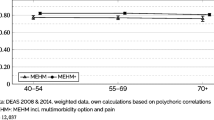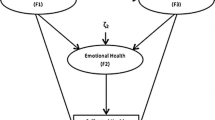Abstract
Self-rated health (SRH) is a multidimensional measure, predictive of morbidity and mortality. Comparative studies of determinants, however, are rare due to a lack of comparable cross-national data. This paper contributes towards filling in this gap, using data for persons aged 50 or higher in 11 European countries from the SHARE study (2004). The analysis aims at identifying key elements composing SRH using multinomial logistic regression models. In addition, the homogeneity of associations across populations is assessed. The findings indicate that education, depression, chronic conditions, mobility difficulties, somatic symptoms and levels of physical activity constitute important components of SRH; ADLs and obesity, on the other hand, are not significant and IADLs are important only in a few countries. All these associations point to the expected direction and are homogeneous across countries. However, demographic factors, age and gender, though significant in many countries have divergent associations. Effects of smoking also differentiate between southern and northern Europe.

Similar content being viewed by others
References
Angel R, Guarnaccia P (1989) Mind, body and culture: somatization among hispanics. Soc Sci Med 28(12):1229–1238
Appels A, Bosma H, Grabauskas V, Gostautas A, Sturmans F (1996) Self-rated health and mortality in a Lithuanian and a Dutch population. Soc Sci Med 42(5):681–689
Arber S, Cooper H (1999) Gender differences in health in later life: the new paradox? Soc Sci Med 48:61–76
Bardage C, Pluijm SMF, Pedersen NL, Deeg DJH, Jylhä M, Noale M, Blumstein T, Otero A (2005) Self-rated health among older adults: a cross-national comparison. Eur J Ageing 2:149–158
Baron-Epel O, Kaplan G (2001) General subjective health status or age-related subjective health status: does it make a difference? Soc Sci Med 53(10):1371–1481
Boffetta P, McLaughlin JK, La Vecchia C, Tarone RE, Lipworth L, Blot WJ (2008) False-positive results in cancer epidemiology: a plea for epistemological modesty. J Natl Cancer Inst 100:988–995
Börsch-Supan A, Brugiavini A, Jürges H, Mackenbach J, Siegrist J, Weber G (eds.) (2005a) Health, ageing and retirement in Europe, first results from the survey of health, ageing and retirement in Europe. Mannheim Research Institute for the Economics of Ageing (MEA), Mannheim
Börsch-Supan A, Hank K, Jürges H (2005b) A new comprehensive and international view on ageing: introducing the “Survey of health, ageing and retirement in Europe”. Eur J Ageing 2(4):245–253
Burström B, Fredlund P (2001) Self rated health: Is it as good a predictor of subsequent mortality among adults in lower as well as in higher Social classes. J Epidemiol Community Health 55(11):836–840
Chan YH (2005) Biostatistics 305. Multinomial logistic regression. Singapore Med J 46(6):259–269
D’Uva TB, O’Donnell O, van Doorslaer E (2008) Differential health reporting by education level and its impact on the measurement of health inequalities among older Europeans. Int J Epidemiol 37:1375–1383
De Luca G, Peracchi F (2005) Survey Participation in the First Wave of SHARE. In: Börsch-Supan A, Jürges H (eds) The survey of health, ageing and retirement in Europe—methodology, Mannheim Research Institute for the Economics of Ageing (MEA), Mannheim, pp 88-101
Delbès C, Gaymu J, Springer S (2006) Women grow old alone, but men grow old with a partner. A European overview. Population and Societies 419 INED, France
DeSalvo KB, Bloser N, Reynolds K, He J, Munter P (2005) Mortality prediction with a single general self-rated question: a meta analysis. J Gen Intern Med 21(3):267–275
Dowd JB, Zajacova A (2007) Does the predictive power of self-rated health for subsequent mortality risk vary by socioeconomic status in the US? Int J Epidemiol 36:1214–1221
Dyer AR (1986) A method for combining results from several prospective epidemiological studies. Stat Med 5:303–317
Eriksson I, Undén AL, Elofsson S (2001) Self-rated health. Comparisons between three different measures. Results from a population study. Int J Epidemiol 30:326–333
Fonda S, Herzog A (2004) Documentation of physical functioning measured in the Health and Retirement Study and the Asset and Health Dynamics among the Oldest Old Study. HRS/AHEAD Documentation Report
Gilmore A, McKee M, Rose R (2002) Determinants of and inequalities in self-perceived health in Ukraine. Soc Sci Med 55:2177–2188
Grundy E, Holt G (2001) The socioeconomic status of older adults: how should we measure it in studies of health inequalities? J Epidemiol Community Health 55(12):895–904
Hsu HC (2005) Gender disparity of successful aging in Taiwan. Women Health 42:1–21
Huisman M, Kunst AE, Mackenbach JP (2003) Socio-economic inequalities in morbidity among the elderly: a European overview. Soc Sci Med 57:861–873
Huisman M, Kunst AE, Mackenbach JP (2005) Inequalities in the prevalence of smoking in the European Union: comparing education and income. Prev Med 40:756–764
Huisman M, van Lenthe F, Mackenbach J (2007) The predictive ability of self-assessed health for mortality in different educational groups. Int J Epidemiol 36:1207–1213
Idler EL, Benyamini Y (1997) Self-rated health and mortality: a review of twenty-seven community studies. J Health Soc Behav 38:21–37
Idler EL, Kasl SV (1991) Health perceptions and survival: do global evaluations of health status really predict mortality? J Gerontol 46(2):S55–S65
Idler EL, Hudson SV, Leventhal H (1999) The meanings of self-ratings of health: a qualitative and quantitative approach. Res Aging 21:458–476
Ioannidis JPA (2005) Why most published research findings are false. PLoS Med 2(8)-e124:696–701
Jürges H (2007) True health vs. response styles: exploring cross-country differences in self-reported health. Health Econ 16:163–178
Jürges H, Avendano M, Mackenbach J (2007) How comparable are different measures of self-rated health? Evidence from five European countries. Discussion Paper 137 Mannheim Research Institute for the Economics of Aging, Mannheim
Kalwij A, van Soest (2005) Item non-response and alternative imputation procedures. in: Börsch-Supan A, Jürges H (eds) the Survey of Health, Ageing and Retirement in Europe—Methodology, Mannheim Research Institute for the Economics of Ageing (MEA), Mannheim, pp 128–150
Katz S (1983) Assessing self maintenance: activities of daily living, mobility and instrumental activities of daily living. J Am Geriatr Soc 31(12):721–726
Katz S, Ford AB, Moskowitz RW, Jackson BA, Jaffe MW (1963) Studies of illness in the aged. The index of ADL: a standardised measure of biological and psychological function. JAMA 185:914–919
Katz S, Downs TD, Cash HR, Grotz RC (1970) Progress in development of the index of ADL. Gerontologist 10:20–30
Kivinen P, Halonen P, Evonen M, Nissinen A (1998) Self-rated health, physician-rated health and associated factors among elderly men: the Finnish cohorts of the seven countries study. Age Ageing 27(1):41–47
Klevmarken AN, Swensson B, Hesselins P (2005) The SHARE sampling procedures and calibrated design weights. In: Börsch-Supan A, Jürges H (eds) The survey of health, ageing and retirement in Europe—methodology, Mannheim Research Institute for the Economics of Ageing (MEA), Mannheim, pp 28–37
Kunst AE, Bos V, Lahelma E, Bartley M, Lissau I, Regitor E, Mielck A, Cardano M, Daalstra J, Geurts J, Helmert U, Lennartsson C, Ramm J, Spadea T, Stronegger W, Mackenbach J (2005) Trends in socioeconomic inequalities in mortality in self-assessed health in 10 European countries. Int J Epidemiol 34(2):295–305
Lahelma E, Martikainen P, Rahkonen O, Silventoinen K (1999) Gender differences in illhealth in Finland: patterns, magnitude and change. Soc Sci Med 48:7–19
Lahelma E, Martikainen P, Rahkonen O, Roos E, Saastamoinen P (2005) Occupational class inequalities across key domains of health: Results from the Helsinki study. Eur J Public Health 15(5):504–510
Lawton MP, Brody EM (1969) Assessment of older people: self-maintaining and instrumental activities of daily living. Gerontologist 9(3):179–186
Lindeboom M, Van Doorslaer E (2004) Cut-point shift and index shift in self-reported health. J Health Econ 23:1083–1099
Macintryre S, Der G, Norrie J (2005) Are there socioeconomic differences in responses to a commonly used self report measure of chronic illness? Int J Epidemiol 34:1284–1290
Mackenbach JP, Kunst AE, Cavelaars A, Groenhof F, Geurts J (1997) Socioeconomic inequalities in morbidity and mortality in western Europe. Lancet 349:1655–1659
Mackenbach JP, Stirbu I, Roskam AR, Schaap MM, Menvielle G, Leinsalu M, Kunst AE (2008) Socioeconomic inequalities in health in 22 European countries. N Engl J Med 358:2468–2481
Murray C, Salomon J, Mathers C, Lopez A (2002) Summary measures of population health: concepts, ethics, measurement and applications. WHO, Geneva
National Statistical Service of Greece (2004) 2001 Census data. Available http://www.statistics.gr Accessed 29 January 2009
Nicholas S, Huppert FA, McWilliams B, Melzer D (2003) Physical and cognitive function. In: Marmot M, Banks J, Blundell R, Lessof C, Nazroo J (eds) Health, wealth and lifestyles of the older population in England: the 2002 english longitudinal study of ageing, IFS, London, pp 249-271
Noale M, Minicuci N, Bardage C, Gindin J, Nikula S, Pluijm S, Rodriguez-Laso A, Maggi S (2005) Predictors of mortality: an international comparison of socio-demographic and health characteristics from six longitudinal studies on aging: the CLESA project. Exp Gerontol 40:89–99
Ongaro F, Salvini S (1995) Understanding self-perceived health in the elderly: an analysis of 1986 Italian data. Eur J Popul 11:123–141
Paccagnella O, Weber G (2005) Household income. In: Börsch-Supan A, Brugiavini A, Jürges H, Mackenbach J, Siegrist J, Weber G (eds.) Health, ageing and retirement in Europe, first results from the survey of health, ageing and retirement in Europe. Mannheim Research Institute for the Economics of Ageing (MEA), Mannheim, pp 296–301
Prince MJ, Reischies F, Beekam ATF, Fuhrer R, Jonker C, Kivela SL, Lawlor BA, Lobo A, Magnusson H, Fichter M, Van Oyen H, Roelands M, Skoog I, Turrina C, Copeland JRM (1999a) Development of the EURO-D scale—a European Union initiative to compare symptoms of depression in 14 European centres. Br J Psychiatry 174:330–338
Prince MJ, Beekam ATF, Deeg DJH, Fuhrer R, Jonker C, Kivela SL, Lawlor BA, Lobo A, Magnusson H, Meller I, Van Oyen H, Reischies F, Roelands M, Skoog I, Turrina C, Copeland JRM (1999b) Depression symptoms in late life assessed using the EURO-D scale. Br J Psychiatry 174:339–345
Quesnel-Valée A (2007) Self-rated health: caught in the crossfire of the quest for ‘true’ health? Int J Epidemiol 36:1161–1164
Robine JM, Jagger C, Euro-REVES group (2003) Creating a coherent set of indicators to monitor health across Europe. Eur J Public Health 13(3 supplement):6–14
SHARE documentation online (2008) Sample. Available http://www.share-project.org/ Accessed 23 December 2008
Simon JG, De Boer JB, Joung IMA, Bosma H, Mackenbach JP (2005) How is your health in general? A qualitative study on self-assessed health. Eur J Public Health 15(2):200–208
Singh-Manoux A, Dugravot A, Shipley MJ, Ferrie JE, Martikainen P, Goldberg M, Zins M (2007) The association between self-rated health and mortality in different socioeconomic groups in the GAZEL cohort study. Int J Epidemiol 36:1222–1228
Statistics Netherlands (CBS) (2004) Institutionalised population no longer decreasing. Available http://www.cbs.nl/ Accessed 15 January 2009
United Nations Educational Scientific and Cultural Organization. (2006) International Standard Classification of Education, ISCED 1997. Re-edition, UIS/TD/06-01, UNESCO-UIS Available http://www.uis.unedco.org, Accessed 5 July 2008
Van Doorslaer E, Gerdtham UG (2003) Does inequality in self-assessed health predict inequality in survival by income? Evidence from Swedish data. Soc Sci Μed 57:1621–1629
Van Ourti T (2003) Socio-economic inequality in ill-health amongst the elderly. Should one use current income or permanent income? J Health Econ 22:187–217
Van Oyen H (2001) The institutionalised population in health surveys. United Nations Statistics Division. ESA/STAT/AC.81/7-6. Available http://unstats.un.org/UNSD/disability/ Accessed 15 Jan 2009
Verbrugge LM, Jette AM (1994) The disablement process. Soc Sci Med 38:1–14
Verropoulou G, Tsimbos C (2007) Socio-demographic and health-related factors affecting depression of the Greek population in later life: an analysis using SHARE data. Eur J Ageing 4(3):171–181
World Health Organization (1996) Health interview surveys: towards international harmonization of methods and instruments. WHO Regional Publications European Series no. 58 WHO Regional Office for Europe, Copenhagen
Zimmer Z, Natividad J, Lin HS, Chayovan N (2000) A cross-national examination of the determinants of self-assessed health. J Health Soc Behav 41(4):465–481
Acknowledgments
The author is thankful to two anonymous referees for their constructive and helpful criticism. This paper uses data from release 2 of SHARE 2004. The SHARE data collection has been primarily funded by the European Commission through the 5th framework programme (project QLK6-CT-2001-00360 in the thematic programme Quality of Life). Additional funding came from the US National Institute on Ageing (U01 AG09740-13S2, P01 AG005842, P01 AG08291, P30 AG12815, Y1-AG-4553-01 and OGHA 04-064). Data collection in Austria (through the Austrian Science Foundation, FWF), Belgium (through the Belgian Science Policy Office) and Switzerland (through BBW/OFES/UFES) was nationally funded. The SHARE data collection in Israel was funded by the US National Institute on Aging (R21 AG025169), by the German–Israeli Foundation for Scientific Research and Development (G.I·F.), and by the National Insurance Institute of Israel. Further support by the European Commission through the 6th framework program (projects SHARE-I3, RII-CT-2006-062193, and COMPARE, CIT5-CT-2005-028857) is gratefully acknowledged. For details see Börsch-Supan et al. (2005a).
Author information
Authors and Affiliations
Corresponding author
Appendix: Questions and items comprising various health indicators
Appendix: Questions and items comprising various health indicators
Mobility difficulties
Because of a physical or health problem, do you have difficulty doing any of the activities on this card? Exclude any difficulties you expect to last less than three months.
Walking 100 m
Sitting for about 2 h
Getting up from a chair after sitting for long periods
Climbing several flights of stairs without resting
Climbing one flight of stairs without resting
Stooping, kneeling, or crouching
Reaching or extending your arms above shoulder level (either arm)
Pulling or pushing large objects like a living room chair
Lifting or carrying weights over 5 kilos, like a heavy bag of groceries
Picking up a small coin from a table
ADL (activities of daily living)
Here are a few more everyday activities. Please tell me if you have any difficulty with these because of a physical, mental, emotional or memory problem. Again exclude any difficulties you expect to last less than 3 months.
Dressing, including putting on shoes and socks
Walking across a room
Bathing or showering
Eating, including cutting up your food
Getting in or out of bed
Using the toilet, including getting up or down
IADL (instrumental activities of daily living)
Using a map to figure out how to get around in a strange place
Preparing a hot meal
Shopping for groceries
Making telephone calls
Taking medications
Doing work around the house or garden
Managing money, such as paying bills and keeping track of expenses
Chronic conditions
Has a doctor ever told you that you had any of the following conditions?
Heart attack including myocardial infarction or coronary thrombosis or any other heart problem including congestive heart failure
High blood pressure or hypertension
High blood cholesterol
A stroke or cerebral vascular disease
Diabetes or high blood sugar
Chronic lung disease such as chronic bronchitis or emphysema
Asthma
Arthritis, including osteoarthritis, or rheumatism
Osteoporosis
Cancer or malignant tumour, including leukaemia or lymphoma, excluding minor skin cancers
Stomach or duodenal ulcer, peptic ulcer
Parkinson disease
Cataracts
Hip fracture or femoral fracture
Other conditions, not yet mentioned
Somatic symptoms
For the past 6 months at least, have you been bothered by any of the following health conditions?
Pain in your back, knees, hips or any other joint
Heart trouble or angina, chest pain during exercise
Breathlessness, difficulty breathing
Persistent cough
Swollen legs
Sleeping problems
Falling down
Fear of falling down
Dizziness, faints or blackouts
Stomach or intestine problems, including constipation, air, diarrhoea
Incontinence or involuntary loss of urine
Other symptoms, not yet mentioned
Depressive symptoms comprising the EURO-D scale
Sadness—Depression
Pessimism
Suicidal tendency
Guilt
Trouble sleeping
Lack of Interest
Irritability
Loss of appetite
Fatigue
Lack of enjoyment
Tearfulness
Lack of concentration
Rights and permissions
About this article
Cite this article
Verropoulou, G. Key elements composing self-rated health in older adults: a comparative study of 11 European countries. Eur J Ageing 6, 213–226 (2009). https://doi.org/10.1007/s10433-009-0125-9
Published:
Issue Date:
DOI: https://doi.org/10.1007/s10433-009-0125-9




